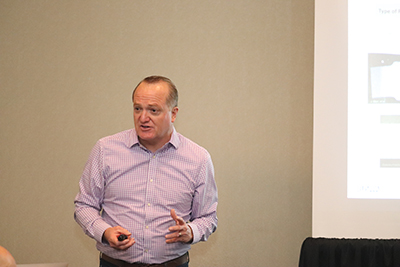

Pipeline Integrity Courses
Texas Training & Conference Centers
September 25-29, 2017
Managing Cracks and Seam Weld Anomalies on Pipelines
September 28-29
This course can be attended in person or online
Click here to read Crack-related excerpts from the Code of Federal Regulations and PHMSA’s Notice of Proposed Rulemakingon new safety regulations for natural gas transmission pipelines.
Click here to see sample course presentation material addressing these issues.
| Course schedule | |
| Day 1-2: | 8am-5pm |
Various forms of cracks or crack-like indications are known to be present on pipelines, which could become a safety concern to their safe operation. The most typical forms of cracking and its derivatives are environment-, manufacturing- or operations-related, such as stress corrosion cracking, corrosion fatigue cracking, hydrogen-induced cracking, hook cracking, and seam-weld anomalies (such as those related to ERW/flash-welded pipe).
This course will provide an integrated, data-driven approach for addressing these forms of cracking and seam-weld anomalies. It covers in greater depth the formation of these types of anomalies and the conditions that drive their growth until they become unstable, leading to leaks or ruptures. The appropriate assessment methods such as ILI crack tools, pressure-testing and direct assessments will be presented as well as traditional and current engineering approaches for establishing crack severity and determining future integrity.
Who Should Attend
- Pipeline engineers and maintenance personnel who are involved or responsible for the maintenance, inspection, assessments and repair of pipeline systems.
- Non-Destructive Inspection personnel who wish to acquire or increase their knowledge of crack formation and growth on pipelines
What Will Be Learned
On completion of the course, the student will understand what factors contribute to the formation and growth of crack‐like features and seam-weld anomalies on pipelines. In addition, the participant will be able to gather and analyze the type and extent of cracking found, key operational parameters, pipe material properties, full-scale testing data, and ILI crack tool data, and to apply industry-recognized engineering methods for developing and recommending appropriate remedial action.
Documentation
Participants will receive a full set of course slides and notes in paper and electronic form, in color throughout.
Lecturer

Sergio Limón is a Sr. Engineering Advisor with Blade Energy Partners responsible for developing, implementing, and executing strategic integrity management programs for gas and liquids pipelines, as well as performing fracture mechanics based structural evaluations, fatigue assessments and failure analyses. Sergio has worked in the oil & gas pipeline industry for more than 22 years with emphasis on pipeline integrity threat analysis and response. He was employed for 10 years with a large owner and operator of natural gas transportation pipelines where he led for six years the Asset Integrity group for the western division responsible for the analysis, response, and remediation of integrity threats. Sergio holds B Sc. and M Sc. degrees in Mechanical Engineering with emphasis in fracture mechanics and materials from the University of Utah.
CEUs
On completion of the course, participants will be awarded 1.4 CEUs.
Course Program
1. Material Behavior and Engineering Fracture Mechanics
- Fracture of metals. Brittle and ductile fracture behavior. Engineering mechanics of crack formation and growth. What factors drive the formation and growth of cracks on pipelines?
- Engineering equations that govern stresses around a crack
2. Characteristics and Behavior of Cracks Found on Pipelines
- What are the various forms of cracks and seam-weld related anomalies typically found on pipelines? Description of SCC or corrosion fatigue, hydrogen-induced, hook cracks, seam-weld anomalies: lack of fusion, cold welds, stitching,
- Are material inclusions, laminations and roll-in slug/scab cracks or not?
3. Evaluating Crack Severity
- What are significant cracks on pipelines? Review of US and Canadian guidelines.
- When do cracks become a safety threat to the pipeline?
- Selecting an appropriate failure criterion
- Evaluating methods for determining crack severity:
- NG-18 Equation derived: KAPA, PAFFC
- Failure Assessment Diagram derived: API-579, BS-7910
- CorLAS
- NG-18 Equation derived: KAPA, PAFFC
- Determining the severity of cracks expected to fail at MAOP and at a Safety Factor x MAOP (such as 1.39 MAOP or 110% SMYS)
- Elements of an O&M procedure for addressing crack severity. What are the guidelines in your O&M procedure with respect to addressing the severity of cracking?
4. Regulations & Recommended Practices
- Review of current U.S. and Canadian regulations and guidelines for addressing cracks and seam weld anomalies
- Review of current industry standards and recommended practices related to addressing cracking and seam weld anomalies
5. Appropriate Crack Assessments
- Factors to consider when deciding the most appropriate assessment method or methods for a particular pipelines segment. When do these assessment methods complement each other to enhance existing remediation program?
- Hydrostatic Testing, In-line Inspection and Direct Assessment
6. Non-Destructive Inspection (NDI)
- The integral role of In-ditch NDI in addressing cracking and SWAs
- Review of current NDI methods and technologies
7. Repairing Crack-like Features and Seam Weld Anomalies
- Review of appropriate repairs options in the industry: ASME, API, PRCI-PDAM, and applicable US and Canadian regulations
- Latest research and developments on repairing cracks and SWAs
8. Elements of Crack & Seam Weld Anomaly Management Strategies
- Know the pipeline material properties, historic pressure tests and operating conditions
- Know the type of cracking or SWA expected or found
- Integrity history of the pipeline
- Crack or SWA susceptibility and threat analysis
- Risk assessment approach
- Appropriate integrity assessments
- NDI protocols and characterization of cracks and SWAs
- Preventive & mitigative measures

